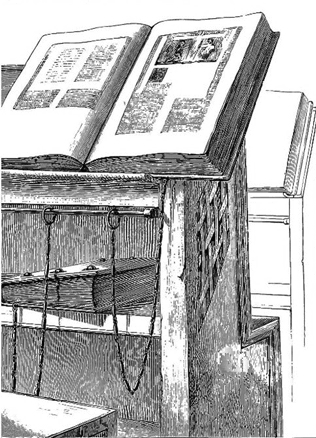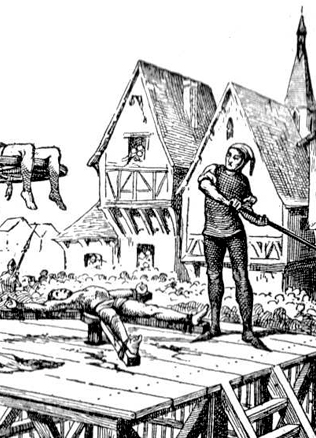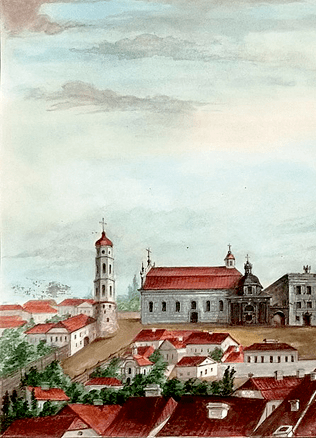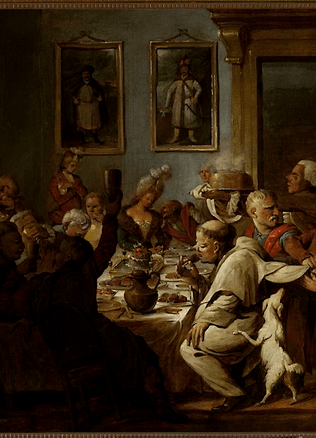Bartolomeo Cinacchi and Other Italians in Vilnius and in the Grand Duchy of Lithuania
Migration is a universal phenomenon characteristic to all societies. Political, religious, demographic and economic factors as well as combinations of various causes determine its extent and nature. Types of migration (economical, religious, political etc.) often interact, while geographic mobility is often caused by social factors too. The process became more intense in the early modern period and involved city residents and villagers, peasants and the nobility. The extent of migration was different, though, as aristocrats would travel up to 1,000 kilometres, while the representatives of the nobility used to manage up to 600 kilometres. Lower-rank people would cover significantly smaller distances: city residents usually moved 150–600 kilometres, while peasants travelled only up to 120 kilometres. Religious wars, urbanisation and overseas expansion were the reasons encouraging migration. People from Italy particularly stand out as active travellers.
Vagabonds from Italy
Italians started their massive migration to France, Hungary, England, Spain and Holland – and to a lesser extent to Poland and Portugal – between 1430 and 1530. Italian Humanists were popular in the late 15th century amid growing interest in antique literature and sciences and lack of educated local people. That was the opportunity for not so “great personalities”, virtually unknown in Italy, to become important in foreign countries. In the second half of the 17th century, Italy’s “golden age” has already gone and the country was living through an economical, political and social crisis that spurred emigration. Some people, unable to find their place at home, tended to look for success abroad. Merchants would choose Holland and Germany, while artisans would go to France and Sweden. Central and Eastern Europe was one of destinations for migrants. Due to price differences, it was enough for an Italian merchant, even for a fairly small one, to arrive in the Polish and Lithuanian Commonwealth where he usually saw his capital grow severalfold. Italian culture reigned the country, because the Baroque society liked everything “Italian”, including food, manners and clothes. This is why even the cold climate could not stop people from arriving. Italian businessmen and artists sometimes went as far as to Russia.
Newcomers from the Apennine Peninsula became a common feature of the national “landscape” in the PLC, especially in larger cities, between the 16th century and the first half of the 18th century.
Many “stars” would arrive for a short stay wishing just to make money and come back to Italy. Some, however, made the PLC their second motherland. Catholic Poland, namely its cities of Krakow, Lvov, Warsaw and Lublin, was a home for the largest Italian diasporas. In the GDL, Italians usually worked for aristocrats in their estates. Vilnius was attracting more representatives of this ethnic minority than any other city of the GDL. The immigrants became famous as artists and artisans of various levels (architects, composers, masons, sculptors, painters); they also included prominent merchants, medics, military engineers and industrialists. Enjoying their place among the business elite in the GDL, they would establish trading and financial companies, lend custom duties, employ new business tools, such as bills of exchange and assignments, and act as key figures in the markets for fabrics and wines. Counting artists from Italy alone, there were 40 of them in Vilnius during the 17th century. Wealthy Italian merchants and bankers based in Krakow, Sebastiano and Valerio Montelupi, had business relations with Vilnius. Tomas Barduci, an Italian who worked as a pantler in Vilnius, was their representative in the capital of the GDL.
The “Godfather” of Vilnius
It was not a coincidence that six Italians were members of the ruling elite in Vilnius between the second half of the 17th century and the first half of the 18th century. Royal Secretary and Advocatus of Vilnius Bartolomeo Cinacchi (ca. 1623–1683), Assessor Jozef Bonfili († 1682), Assessor Leonardo Ricchi († po 1685), Wojt Joannes Melchiorini († ca. 1715), Assesor Joannes Pensa († ca. 1716) and Assessor Ludovico Bernardo Caetano Loretti (1680–1742) all were Catholic citizens of Vilnius who arrived in the city from different regions of Italy in search for opportunities of a better life. Some of them lived in the capital of the GDL longer, some stayed shorter, but most found here their personal success and riches. They married in Vilnius and many of their children tied their destiny with the GDL.
Bartolomeo Cinacchi – the royal secretary, the advocatus of Vilnius, the tax administrator of the GDL and the head of Vilnius Post Office – was the most influential Italian to have lived in Vilnius as its citizen. He was a remarkably rich merchant and banker in the context of Vilnius and the whole GDL; he maintained close relationship with the Pac family. He arrived in Vilnius from the Republic of Lucca in about 1650 together with his brother Joannes who eventually settled in Warsaw. He accrued his wealth in Lithuania thanks to trade in expensive fabrics and wines and through lending money to the state and to aristocrats. He ran a big business and employed more than a dozen trade agents. He bought two stone houses in Vilnius, one in the City Hall Square, another in the Horse Street. He also enjoyed a successful municipal career becoming a pantler in 1663 and receiving the privilege of advocatus in 1680.
Cinacchi preserved his national identity even after spending 50 years in the PLC.
He learned Polish but wore Venetian or French clothes rather than local ones and supported his fellow-countrymen. The proof is the history of construction of a bridge across River Neris in 1671–1673. The bridge, destroyed during the wars in the middle of the 17th century, was designed by Joannes Baptista Frediani, the Italian architect who was involved in the building of the monastery in Pažaislis and St. Peter and St. Paul’s Church in Vilnius and who promised to erect the bridge “unseen nowhere in the world” in Vilnius. He began building a 73-metre wooden arch bridge for 6,000 goldens, cheaper than the price offered by local masters. Cinacchi personally warranted the deal. Despite that, the costs went up more than threefold, to 20,000 goldens. The bridge, built in the place where River Neris was 400 feet wide, collapsed and floated down the stream together with ice in the evening of the 10th of January 1673. Assessor Jan Kazimierz Berkinowicz and two of his servants tried to search for the remains of the bridge reaching as far downstream as Kaunas but found nothing. The architect accused the city authorities of failing to provide him all necessary materials. The trial against Cinacchi’s countryman was underway in 1676 too.
Italian solidarity
Jozef Bonfili also was grateful to Cinacchi after he had pushed Bonfili through to the office of municipal assessor. This is why people called him Cinacchi’s “superintendant”. Bonfili found his new home, a successful career and a wife in Vilnius where he married Ana, the daughter of the local pharmacist Stanislaus Schenmann, and had two daughters and two sons with her. He was a well-off merchant and owned two stone houses in Vilnius and several shops, one of them selling wine. He was closely related to the German environment of Vilnius, most probably because of his contacts with his wife’s German relatives. On the other hand, he was considerably more Polonised than his patron Cinacchi, because he wore local clothes and spoke Polish. Cinacchi also acted as a mediator when merchant Leonardo Ricchi moved to the GDL.
Cinacchi supported Ricchi in his municipal career after he arrived from Lucca and became a full-fledged citizen of Vilnius in 1682.
Very soon, just one day after he became citizen, Ricchi emerged as a candidate to take the office of pantler, while in less than one year he became assessor in Vilnius.
Joannes Melchiorini, the royal secretary and the doctor of medicine, settled down in Vilnius in 1698 where he married Constance, the granddaughter of the burgomaster Andrzej Ogurcewicz. King Augustus II’s protection has helped him to ascend to the ruling elite of the city. Melchiorini became a pantler in 1701 and an assessor one year later. In 1713, he was granted the privilege of wojt. Sculptor and architect Joannes Pensa maintained close contacts with his fellow-countrymen sculptors Pietro Perti and Andrea Capone after moving to Vilnius from Venice. He became a member of the city elite in 1706 when he was appointed in charge of rebuilding of the burned down City Hall. He became a pantler in 1712 and took the office of assessor in 1715. The unexpected death terminated his municipal career as he was buried under the rubble of vaults of the Jesuit chapel in Lukiškės that collapsed due to improper stonework. Ludovico Bernardo Caetano Loretti was elected assessor of Vilnius in 1714, just one year after moving to the city and thanks to the efforts of his fellow-countrymen Melchiorini and Pensa. In addition to his work in the municipality, he ran a trading business and enjoyed modest benefits from the city’s coffers working as a superintendant of spitals.
All of this shows that the capital of the GDL was undergoing true “Italisation” between the middle of the 17th century and the middle of the 18th century. The Italians who managed to make it to the ruling elite of the city experienced plenty of extraordinary adventures in their new motherland.
Literature: A. Ragauskas, „Bartholomeus Cynaki ir Co“. Italai Vilniaus miesto valdančiajame elite XVII a. antrojoje – XVIII a. pirmojoje pusėje, Lietuva ir pasaulis: bendradarbiavimas ir konfliktas, Vilnius, 2000, p. 178–205.
Aivas Ragauskas



